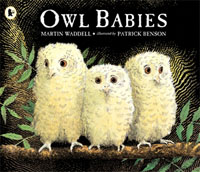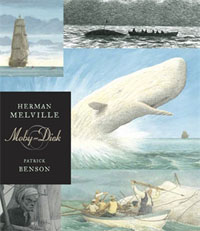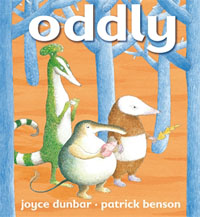|
We had a real treat last week here at Walker, when illustrator Patrick Benson popped in to talk at our sales conference. Patrick has been a part of Walker for a long time, since a chance meeting with the sister of Sebastian Walker (founder of Walker Books) introduced him to the company. In that time he has worked on a huge number of books including Owl Babies with Martin Waddell and more recently he has been illustrating the epic classic Moby Dick. His latest book Oddly is a collaboration with writer Joyce Dunbar, publishing in May 2009.
So where does Patrick get his inspiration from? How does he relate to the books he illustrates? And how does he begin to illustrate a story? Here he talks us through what was going through his mind when he was reading the manuscript for Oddly:
|
 |
|
'I often use the concept of being a film maker when I am trying to work out how to illustrate a story, and I find it especially helpful in getting the pacing of a book right. Like all of us, I have seen a mass of visual images in my life, first-hand or in film or books. They are all stored away somewhere in my brain, and it is these images which I try out to see if I have a fit. Images will be used, adapted or discarded, as I decide whether or not they are of any use in the business of illustrating a text.
When I am asked to illustrate a picture book, I presume it is because there is a chance I may come up with interesting imagery which will add to the story; also because I have the technical ability to actually draw what is going on in my head! I am there to interpret the emotional journey within a picture book and to create a visual world within which the story can take place. I am not there to pedantically explain everything that goes on in the story. Rather, I aim to provide children with some visual clues, which hopefully they will use to enter the world of the story and go on their own journey. I always think of my job as providing a springboard for children’s imaginations: interesting images will stimulate their imaginations and help them to enjoy the process of reading a story. If you are good at doing this, you can allow a child to imagine almost anything, and that is part of the fun of being a children’s book illustrator.
|
 |
|
Oddly is a lovely, strange and quirky piece of writing by Joyce Dunbar. The key to this particular illustration puzzle came from the lines that the three little characters first utter: where am I, what am I, and who am I. Unintentionally, I think, I was immediately reminded of the Bunyip's first words in The Bunyip of Berkeley’s Creek by Ron Brooks. I became convinced that this little story had to happen in Australia! A decidion like this is a pretty arbitrary decision, but it provides a starting point which may – or may not – be of use. There was nothing concrete in the story to suggest it, just the feeling it should be a foreign landscape with bright colours and sharp shadows, visually as unfamiliar as possible to a Western child. But it wasn't just the text that influenced me – that line reminding me of an Australian picture book, the words "shadows" and "dreams". The work I had been doing previously was also a factor. I had just finished Moby Dick, which was very dark, a lot of black-and-white drawings, which had to be very realistic to illustrate the technique of catching whales using harpoons and small boats, and bring the characters to life. Before that I had done a couple of books about moles, full of pastoral scenes, fields and trees, with as ‘English’ a feel as possible. So the opportunity provided by Oddly to discover a completely different world was extremely attractive.
|
 |
|
As for the characters, there were very few clues in the writing as to what they should be like, so it was more or less up to me. I have no idea what Joyce was imagining as she wrote about these three characters, and I can only hope that she is not too appalled by the way they appear in the book! The process happens like this. I think first of the sort of animals that inhabit Australia, partly encouraged by a line (later dropped) describing the Strangelet reaching for the pebble in his pocket. I think of marsupials and pouches. I like echidnas, the spiny anteaters. Then I think of pangolins, in the same family, and I come up with a sort of an amalgam that feels like a Lostlet: a small, banded – I like belted Galloway cattle – hairy, friendly character who can easily hold a leaf in one hand. So now I have the Lostlet. The Stranglet lives in the shadows, so I think of forest-dwelling animals. An okapi comes to mind, but he has to skip and also hold something in his hand, thus he needs to be on two hind legs. He must be balanced, thus a tail, but not like a kangaroo, more like a kinkajou. Of course, living in the shadows, his coat is banded for camouflage, and for some inexplicable reason he has what looks like broccoli growing out of his forehead. Strange indeed – so he becomes the Strangelet. And then there is the Oddlet, who flips right over on first meeting the little boy. He becomes the comedian, a completely round character with a long snout. I was thinking of an Edward Gorey character called the 'Doubtful Guest', and in some way this is what shaped the Oddlet’s head. Then of course there was the practical problem of holding the shell and dancing in the waves, so legs and arms had to be fitted on: thus the odd shape of the Oddlet!
|
 |
|
Having got the characters, what of their world? And how does a little boy fit into it? I got bogged down at first by the objects which each of the characters have and subsequently give to the little boy as an act of love. These objects are incredibly important, so I say to myself that there cannot be other leaves or stones or shells in this world. But there is water and there are shadows … and what else? What I came up with was a slightly weird landscape within which the story can happen, and with a sparseness that I hope concentrates the attention of the reader on the interaction between the four characters. As with Owl Babies, the way the story unfolds can be seen as a film: introducing characters, setting the scene, long shots, close-ups, the main action in the middle, the close-up of each character with the little boy, then finishing with the final closing shot of a happy resolution.
It isn’t a loud book – like the story, it is a quirky, strange, odd little book. I hope, unlike the first character, it won’t be a lost little book. That’s up to you the reader!'
|
|
| |
|